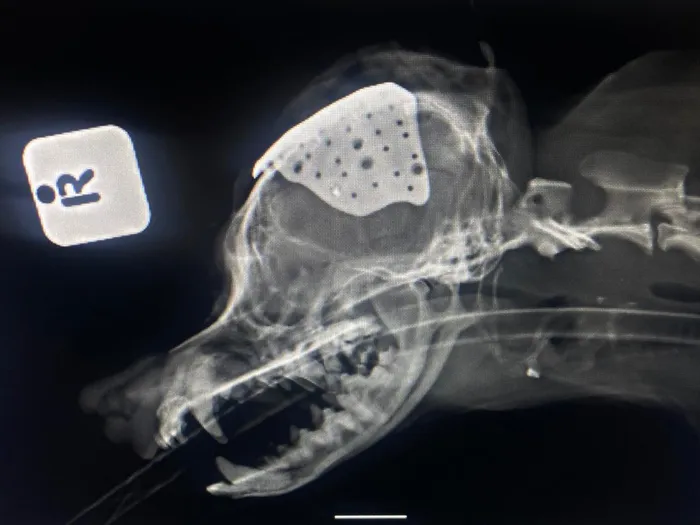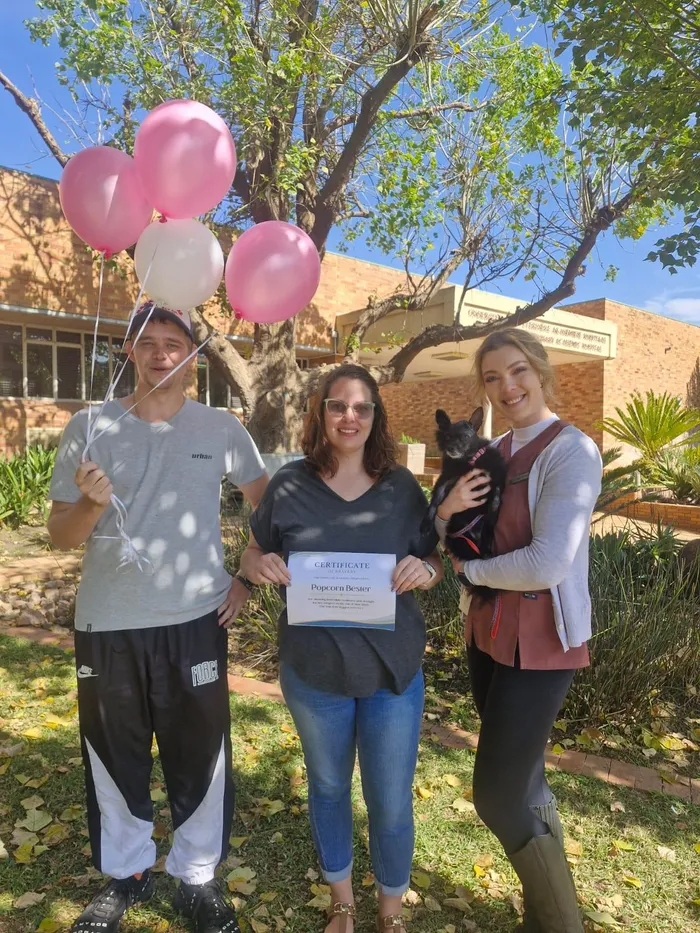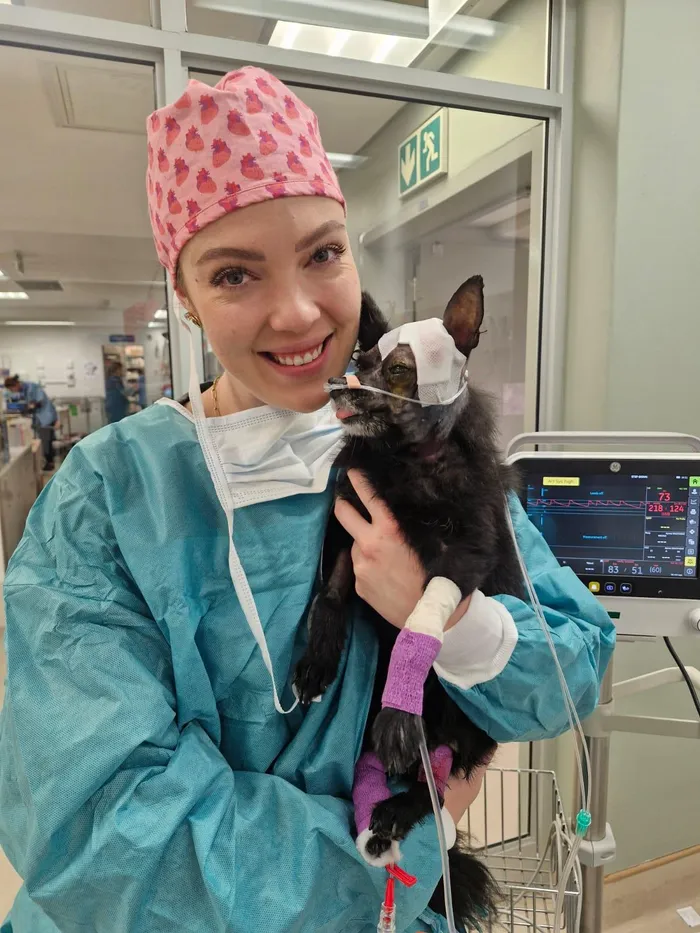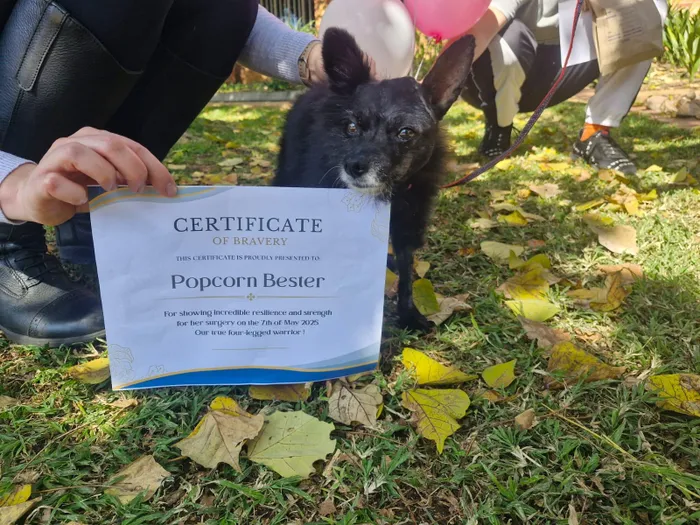Popcorn the 'hard-headed' Pomeranian makes a remarkable recovery with a 3D-printed skull
DOG SURGERY

Radiographic side view (right lateral) of Popcorn's skull indicating the irregularly shaped custom printed titanium plate on top of her skull.
Image: SUPPLIED
A team of veterinarians from the University of Pretoria’s (UP) – armed with a “3D-printed skull” – saved the life of Popcorn, an eight-year-old Pomeranian, after she had been bitten by another dog and sustained a severe head injury.
When Popcorn, who was injured during a fight in February, was brought into the Faculty of Veterinary Science’s Onderstepoort Veterinary Academic Hospital (OVAH) in May, her future was uncertain. She had sustained a severe injury known as a comminuted, depressed skull fracture. Comminuted fractures are serious bone breaks, usually caused by high-impact trauma, where the bone shatters into three or more pieces.
Fragments of bone were pressing on and into Popcorn’s brain, leaving her weak, off-balance and at risk of seizures.
“Our team’s first priority was to stabilise her,” says Dr Shannon van Rooyen, surgical resident at the OVAH, who was instrumental in the stabilising process and the surgical procedure. “Once she was strong enough, a CT scan was performed to create a 3D model of her skull. From this, a custom-made titanium plate was designed and printed to fit the outside of her skull perfectly.”

Dr Shannon van Rooyen (right) with owner Ms Mikaela Bester (middle) and her brother, Brandon Marshall on the day of Popcorn's release from hospital.
Image: SUPPLIED
Small Celebration
Dr van Rooyen performed the delicate operation Popcorn needed, with guidance from Dr Adriaan Kitshoff, a specialist surgeon and Head of the Small Animal Surgery Section of the Faculty’s Department of Companion Animal Clinical Studies (CACS).
“During the surgery, the loose bone fragments were carefully removed to relieve pressure on her brain, and the titanium plate was placed to reconstruct her skull and protect her from future trauma,” Dr Kitshoff said. After her operation, Popcorn recovered in the hospital’s intensive care unit for two weeks, supported round the clock by the OVAH’s dedicated clinicians and veterinary students, who cared for her with patience and love.
When Popcorn was stable and healthy enough to be discharged from the hospital, Dr van Rooyen arranged a small celebration, at which Popcorn received a Certificate of Bravery for her incredible courage and strength.

Dr Shannon van Rooyen, surgical resident in the OVAH with Popcorn just after her operation.
Image: SUPPLIED
Courage
“Popcorn’s journey is a story of courage, innovation, and hope. It reflects not only the advances of modern veterinary medicine, but also the unwavering dedication of a specialised team that refused to give up. Most of all, it reminds us of the deep and unbreakable bond we share with our pets, the kind of love that inspires us to fight for their recovery, celebrate their milestones, and treasure every moment together,” Dr van Rooyen said.
After the surgery, the veterinary team advised Popcorn’s owner, Mikaela Bester of Newcastle, KwaZulu-Natal, to keep Popcorn in a quiet room with non-slip flooring for four weeks. Popcorn’s activity was restricted to short bathroom breaks, and she was kept on a leash to discourage her from running and jumping. Normal activity levels were slowly reintroduced during this four-week period. “Recovering from large surgeries like this also involves physiotherapy and nursing care, which included soft bedding and careful wound monitoring,” Dr van Rooyen said.
Bester says Popcorn has returned to her pre-accident “hard-headed” self and is once again absorbed by her favourite daily activities. “She is eating, playing, and enjoying life again. She remains the bright, happy companion we adore.”

The certificate of bravery that was given to Popcorn to celebrate her discharge and brave journey of resilience and strength.
Image: SUPPLIED
Related Topics: